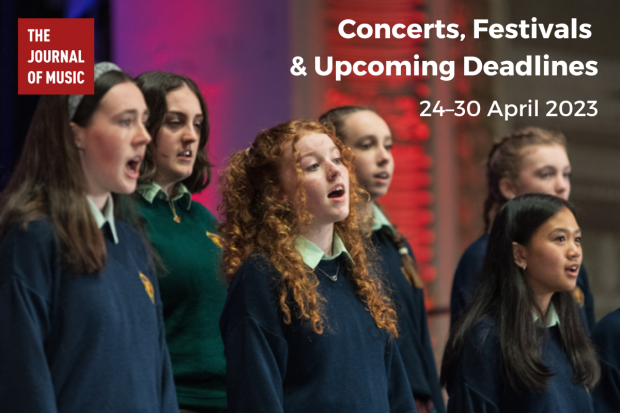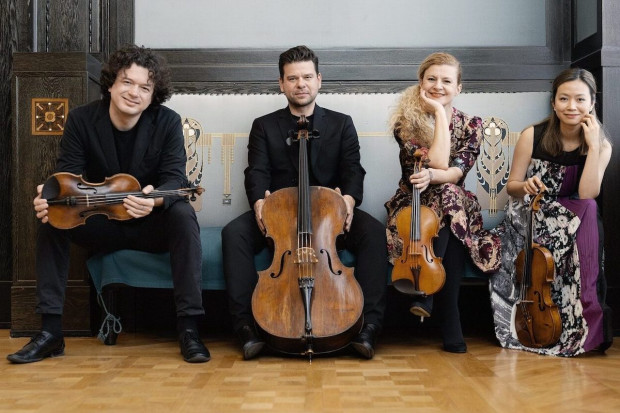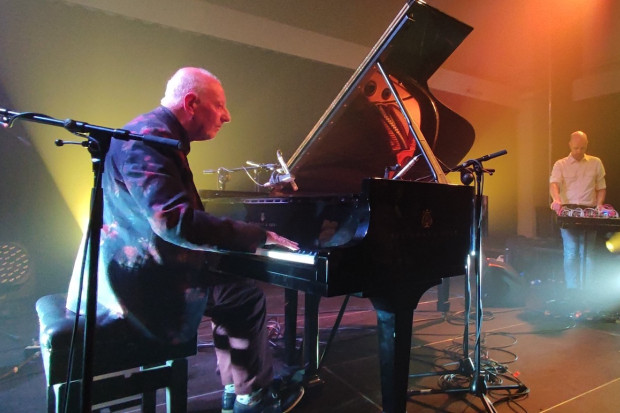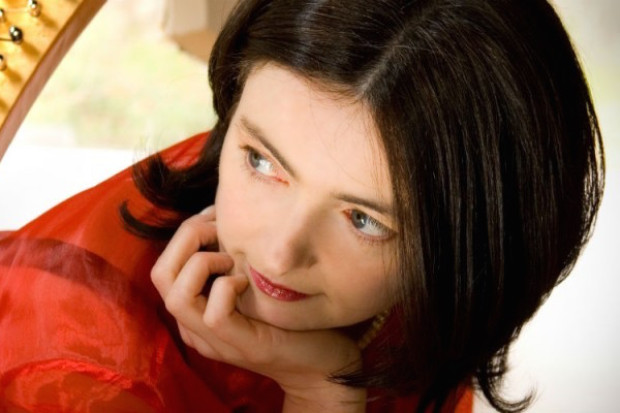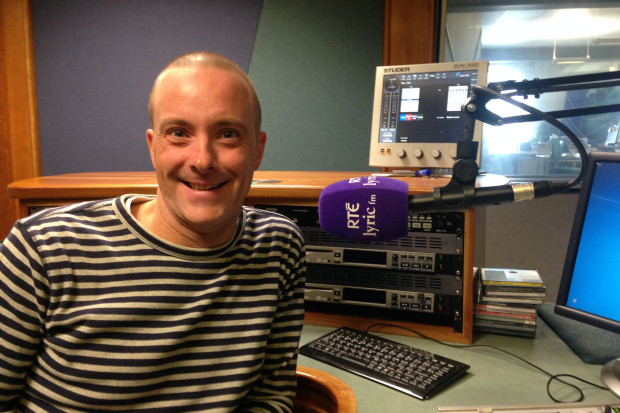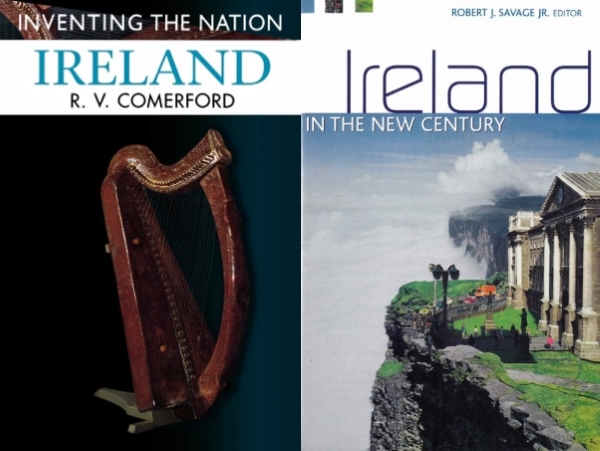
Pacto de Olvido?
Inventing the Nation (Ireland) R. V. ComerfordGen. Ed. Keith Robbins
London, Hodder Arnold, 2003
Ireland in the New Century
ed. by Robert J. Savage Jr
Dublin, Four Courts Press, 2003
Inventing the Nation
Inventing the Nation[1] is the title of a recently published history of Ireland by Richard Comerford (Professor of Modern History at the National University of Ireland). Its eight chapters endeavour to assess Irish history in a fashionably revisionist mode. The one that concerns us here is number six, entitled ‘Music, song and dance’. In his Introduction, Comerford sets out to lay the position from which he will deliver his view of the constant ‘invention’ or unfolding of Irish culture. In order to achieve this he attempts to make a distinction between two divergent definitions of what characterises ‘nation’ – one, an essentialist view, based on the assumption of a ‘natural law’ or the belief that nations are ‘individually prescribed by nature or by some divine plan’ and, the other, which supports the concept of the nation as a ‘construct’ (and not a given), an ongoing process which is as much influenced by chance as it is by prescription and special interest manipulation. In his own words, Comerford determines that ‘Irishness is not an essence to be identified in various emanations, but a category whose ever-changing contents need to be accounted for.’
I highlight this point as it allows us to see, in relation to the chapter in question, the extent to which Comerford has failed to ‘account’ for the ‘ever-changing’ facets of Irish culture in relation to music. He has, by his own admission, endeavoured to ‘explore the particularity and complexity of the subject’ and although he wishes to avoid elaborating any theory, he does admit that the book is written ‘in the understanding that the attempt to present knowledge in a systematic form is one of the obligations of scholarship.’
How, then, can he explain the absolute and complete absence in his chapter on music of an outline and assessment of Irish art music (save for the dreadfully tiring and seemingly obligatory mention of Ó Riada)?[2] Just how, one might ask, can the ‘particularity and complexity of the subject’ be appreciated when (bar Ó Riada’s mediocre attempts in the genre) almost a century of Irish art music has been completely airbrushed from the argument? How can any serious debate on music in Ireland, how music forms the nation, be contemplated with the total exclusion from the argument of the work (in many cases both artistic and educational) of Aloys Fleischmann, Frederick May, Brian Boydell, James Wilson, Seóirse Bodley, John Kinsella, Gerard Victory, Raymond Deane, Gerald Barry, John Buckley, Jane O’Leary, Frank Corcoran, Roger Doyle, Michael Alcorn, not to mention a host of other critical voices in Irish musical life? The gap is so great, the oversight so vast, that it would seem to subdue any authority Comerford might claim for his work. I suggest that, were this oversight not uncommon, it would place his other research in peril. As the airbrushing of the Irish art composer is, in fact, quite a frequent phenomenon, not only in social histories and musicological treatises but also in practical areas like Irish cultural retrospectives abroad (more of which later), we can at least come to the conclusion that Comerford’s research in other areas does not necessarily automatically suffer from the same defects.
There is a further paradox lying at the heart of this. As has been noted, Comerford is at pains to offer an alternative to the ‘essentialist’, nationalist view of Irish history. This revisionist practice has been central to the recent writing of Irish history and has amongst its ambassadors such eminent historians as F. S. Lyons and Roy Foster. The extraordinary factor here is, had Comerford any inkling as to the real state of affairs in modern Irish music society, he could have used the dynamic, international, robust, highly innovative and essentially eclectic facets of contemporary classical Irish music to prove his stance in relation to a theory of ‘nation’ as a ‘category whose ever-changing contents’ need to be accounted for. It would have provided him with a perfect model to ‘convey the … changing connotations of Irishness’ he promises to attempt in his Introduction.
Even a short perusal of the character and origins of twentieth century Irish classical music will reveal an astonishing level of eclecticism and individuality ranging from the first attempts at modernism of Boydell, May and Fleischmann, through the growing Europeanisation of Irish art music at the hands of Barry, Deane, Buckley, Corcoran, Doyle and J. O’Leary, to the new generation emerging within the past ten years which has, in varying degrees, absorbed modern technological processes into its work and has, in some distinct quarters, displayed an influence coming not so much from Berlin but Boston. Working studiously away in the background, therefore, is a complete body of Irish artists which has largely and very successfully re-shaped the voice of Irish music, and which (for numerous complex reasons) has been neither absorbed into a restricted ‘Irish’ aesthetic nor a constraining ‘European’ one. In fact, it is a unique characteristic of Irish art music that it displays an extraordinary amount of eclecticism and distinctiveness, a freedom from any prescribed aesthetic, which in many ways, it could be argued, does not nearly exist to the same degree in any other art forms emerging from this island.
The actual quality and depth of work Comerford displays in his other chapters makes the complete exclusion of the art music genre from his book even more startling. It should be noted that there is more than a mere ‘list’ of Irish art composers missing here. The array of socio-political structures which have developed around the genre have been hugely significant to, and reflective of, Irish society as a whole. Take, for example, the gender issue. The number of women working today as active composers is truly prodigal. From Jane O’Leary to Judith Ring, Irish women are producing an astonishing quantity of extraordinarily rich music.[3] The Contemporary Music Centre has emerged in recent years as an enormously significant archival service housing the works (in scores and recordings) of up to one hundred active composers. Music Network has literally altered the face of classical music in Ireland, sending Irish and international performers throughout the country and allowing access for those ‘beyond the pale’ to music and artists of international stature. In nearly all cases, the inclusion in the programme of a work by an Irish composer (often newly commissioned) has been a prerequisite for any performing artist or group working with Music Network. The composer-in-residence schemes sprinkled throughout the country are further verification of the de-centralisation of art music in Ireland and a growing consciousness nationwide of Irish art composers.
The majority of these developments have taken place within the context of (at the very least) uneven support from the Arts Council and an appalling educational system in relation to music. Notwithstanding this, the last twenty years has seen the development of festivals and events such as the Sligo Contemporary Music Festival, the Ennis School of Composition, the RTÉ Living Music Festival, the Sonorities festival, the Composers’ Choice series at the National Concert Hall, the Mostly Modern series at the Bank of Ireland Arts Centre, Opera Theatre Company (for new Irish opera), the National Symphony Orchestra’s Horizons series, the Hugh Lane Gallery’s Sunday at Noon series, not to mention the emergence of the new music ensembles Concorde, Vox21, Crash, Whispering Gallery and Double Adaptor. This is merely a swift perusal. The face of Irish art music has altered radically since the death of Ó Riada and the social implications of this have been so extraordinary and far-reaching that it would not be an exaggeration to describe these developments as a new renaissance.
But, alas, nothing of this hugely significant sea-change within Irish musical society has been recorded in Comerford’s history. For him, twentieth century Irish music starts with Ó Riada and is then strangely diverted through the Chieftains towards the usual suspects of Shaun Davey and Bill Whelan’s Riverdance. While all the above-mentioned composers and developments have been completely eliminated from his version of history, Comerford considers the sonic wallpaper of Enya’s ‘particularly wistful style’[4] significant enough for inclusion. And to prove just how considerable the Eurovision Song Contest has been to contemporary Irish culture, he includes a photograph of an angelic Eimear Quinn winning the contest in Oslo in 1996. The fact that pre-published drafts of this insubstantial effort at an Irish music history underwent the scrutiny of three scholars just adds to the bewilderment one feels in reading the final published chapter.[5]
Ireland in the New Century
Is this just a one-off mishap of sorts? Apparently, it is not. Another recently published book on modern Ireland – Ireland in the New Century – Politics, culture and identity[6] – suffers from the same myopia. This publication offers a series of papers initially given at a conference as part of a major two-week festival entitled ‘Island: Arts from Ireland’. Of the twelve very interesting essays offered in the collection, none deals with the area of Irish art music. There is one essay given by Mícheál Ó Súilleabháin, which, naturally, emphasises areas of his own interest such as ‘world’ music and its natural capacity to engage with the new globalised reality. Like Comerford, the book’s editor, Robert Savage, claims for his collection of essays a broad diversity. ‘An interdisciplinary approach … is essential for us to have a comprehensive understanding of Ireland in the new century.’[7] How can a ‘comprehensive understanding’ be attained when not one essay within this collection addresses the area of Irish art music?[8] I searched in vain in the editor’s Introduction for mention of an Irish art music composer or even allusion to the genre but to no avail. I did, however, come across, yet again, reference to Riverdance as the perfect example of a new renaissance in Irish culture. Without wishing at all to decry or admonish the triumph of Riverdance, it seems that ‘international success’ (and a prowess for making financial profit) is in many quarters, sadly, the modern benchmark for cultural richness.
But what accounts for the defects in these two recently published assessments of Irish contemporary culture? I mentioned previously that they are not the only cases in point. Although (as I have described earlier) things have been improving in recent times, the presence of contemporary Irish music on the calendars of the main concert halls has been traditionally poor (it took seventeen years for the National Concert Hall to present an on-going contemporary music festival). Why has this been the case? New music’s beleaguered position is reflected not only in the level of Arts Council funding but also in the level of membership of Irish composers to Aosdána.[9] What can be the reason for this? The broad failure of Irish musicology to provide anything close to an accurate assessment of the genre is notable. Why should this be? The astonishingly poor level of inclusion of contemporary Irish music in festivals and conferences abroad (when not organised by Irish composers themselves), which purport to celebrate Irish culture in all its modes, has perhaps been the saddest aspect of this phenomenon. Why, for example, was there a complete omission of contemporary Irish music from a conference held recently in Virginia, USA, on ‘Re-imagining Ireland’?
Raymond Deane has been perhaps the most articulate voice in suggesting some answers to these wearisome questions. In his paper ‘Caterer and Comforter? The Composer in Modern Ireland’[10] he argues that, out of all art categories, music in its tonal form can be most easily exploited (from its use in advertisements to its presentation in the concert hall) as a comforter, as an anaesthetic to ‘lull’ the weary, over-worked listener into ‘the pleasant conviction that everything is in its place in the best of all possible worlds.’[11] This would seem to be the fashionable ethos underpinning the programming of new breed of Irish radio stations like Lyric FM and Lite FM. Behind this concept, Deane suggests, lies a ‘totalitarian imperative’[12] which he has referred to again more recently in his JMI article ‘Identity on Parade’[13] where he refers to the exclusion of new Irish music from the above-mentioned ‘Re-imagining Ireland’ conference. Here, he outlines for us that this event[14] was designed and formulated by Fintan O’Toole and ten project consultants. Deane argues, reasonably, that the exclusion could hardly have been as a result of ignorance. He suggests, therefore, that the embargo must have been deliberate, that Irish classical music ‘quite simply didn’t fit in with a template of Irish identity that covertly lay behind the selection procedures for the event’.[15] When the agenda behind certain musical retrospectives is to sell Ireland, to promote an idea of Ireland for touristic and marketing purposes, to develop a platform for more accessible forms of indigenous music, contemporary Irish classical music has no true role to play. As it is neither obviously and superficially indigenous nor susceptible to mass marketing, its exclusion from the 1999 ‘expo’ of Irish musical culture at the Barbican Centre in London (‘From the Heart’) is probably not surprising.
Two histories
Taking all this into account, one is lead to the conclusion that there are two histories of Irish art music which are unfolding simultaneously. One which takes place in real time, geographically, affecting society, largely unrecognised, unwritten but emanating from college and stage, officially forgotten but reflecting in the moment, what I have called elsewhere, the demeanour of contemporary consciousness. Then there is the other, invented version (and here, Comerford’s title ironically exposes a double entendre) of Irish music history (be it in published form or in foreign conference or retrospective) which tells only the story it wants to tell, which decides what is acceptable or advantageous for inclusion and what is not. The trouble is that this second invented version, though it may not reflect the demeanour of contemporary consciousness, certainly colours an objective assessment of it.
One should not for a moment underestimate the power of these proxy histories and how they self-perpetuate. It is worth noting that Comerford has relied not insubstantially on previously published negative histories of Irish art music by Harry White and Joseph Ryan to validate his own version of events[16] (in fact, it is striking the degree to which White and Comerford both emphasise the importance of Ó Riada to the neglect of the vast majority of Irish composers).[17] The very fact that grave omissions are perpetrated within the sphere of so-called high academia helps us understand why such thwarted views are disseminated throughout society and into socio-cultural structures. Ranging from a simple (Department of Education-approved) text-book like Claire Grady’s Tuned In[18] to the latest edition of Irish Musical Studies,[19] inaccurate and insubstantial versions of the contemporary Irish music panorama are being articulated and circulated.[20] It is also worth noting that Comerford’s Inventing Ireland is part of a series of histories published in London and distributed in the United States, and so one can reasonably assume that the circulation of this material throughout universities and libraries worldwide is substantial. The same could probably be said for Savage’s book.
One does not willingly want to indulge in conspiracy theories. However, the consistent airbrushing of Irish art music from histories and cultural retrospectives leads one to conclude that some sort of pacto de olvido is at play. The reasons for this are numerous and multifaceted and I think Deane has exposed some of them. However, the complexity of the situation would suggests that more scrutiny is required if we are to have a fuller explanation. For certain, the non-verbal nature of music makes it a difficult medium to articulate its meaning, verbally, outside of itself. But the contextualisation of the composer and his or her locale in society need not be. And I suggest that, at least, one step towards reversing this ‘pact of oblivion’ is for composers themselves to become more articulate, more present, more participatory in the various social strata that form our culture. We perhaps need to communicate more, to verbalise more our presence in (to invoke Milan Kundera) the struggle against memory and forgetting.
Notes
1. Inventing the Nation (Ireland), Vincent Comerford, Gen. Ed. Keith Robbins, London, Hodder Arnold, 2003.
2. His mention of Charles Villiers Stanford is hardly significant as by most assessments, Stanford can be considered an English composer, living, working and writing well within an English tradition. See, for example, A. Klein, ‘Roots and directions in twentieth-century Irish art music’, Irish Musical Studies 7: Irish Music in the Twentieth Century, ed. by G. Cox and A. Klein, Dublin, Four Courts Press, 2003.
3. Indeed, as pointed out by Axel Klein, Irish woman have, since before the turn of the last century been very active composers. See again, his ‘Roots and directions in twentieth-century Irish art music’.
4. Inventing the Nation, Ch. 6, p. 209.
5. See Acknowledgements. The three scholars acknowledged are Dr Barra Boydell, Dr Michael Finnegan and Mary Friel.
6. Ireland in the New Century, ed. by Robert J. Savage Jr, Dublin, Four Courts Press, 2003.
7. Ibid, Introduction, p. 21.
8. Interesting essays do appear, however, on contemporary Irish film, literature and visual arts.
9. The state-sponsored Academy of Creative Artists in Ireland. At the time of writing the membership was divided as follows: visual artists 90; writers 84; composers 19. Source: Aosdána website, 1 December 2003.
10. Raymond Deane, ‘Caterer and Comforter? The Composer in Modern Ireland’, The Irish Review, No. 8, Spring 1990, pp. 1-4.
11. Ibid, p. 3.
12. Ibid.
13. See JMI, Vol. 3 No. 5, July-August 2003.
14. Created under the auspices of the Virginia Foundation for Humanities.
15. Ibid, p. 7.
16. In total, five references were made to the work of both musicologists in the part of the chapter dealing with Irish music from the nineteenth century onwards.
17. Readers of JMI will, of course, be aware that White’s and Ryan’s theses have been hotly contested.
18. Claire O’Grady, Tuned In, Dublin, Educational Company, 1992.
19. Irish Musical Studies 7: Irish Music in the Twentieth Century, ed. by G. Cox and A. Klein, Dublin, Four Courts Press, 2003.
20. See my review of Irish Musical Studies 7 in JMI, Vol. 3 No. 6, September-October 2003.
Published on 1 January 2004
Benjamin Dwyer is a guitarist and composer and the author of 'Different Voices: Irish Music and Music in Ireland'. He is Professor of Music at Middlesex University's Faculty of Arts and Creative Industries.












